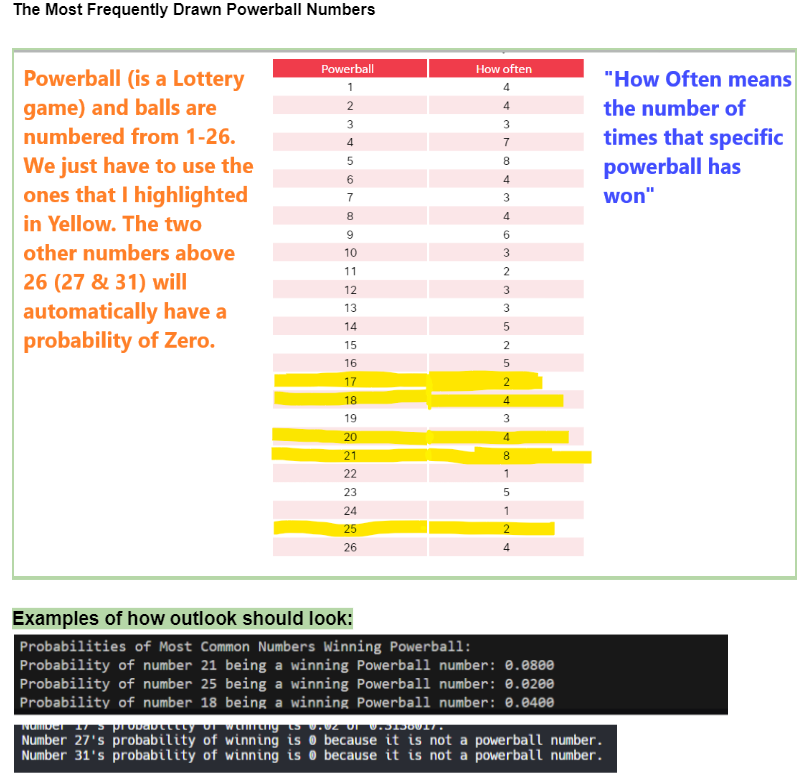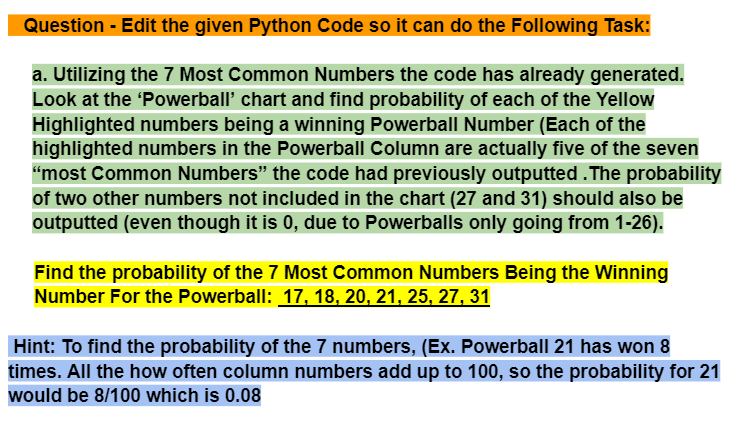The Most Frequently Drawn Powerball Numbers Powerball (is a Lottery game) and balls are numbered from 1-26. We just have to use the ones that I highlighted in Yellow. The two other numbers above 26 (27 & 31) will automatically have a probability of Zero. Powerball How often 1 4 2 4 3 3 4 7 5 8 69 4 7 3 8 4 9 6 10 3 11 2 12 3 13 3 14 5 15 16 2 5 17 2 18 4 19 3 20 4 21 8 22 1 23 5 24 1 25 2 26 4 Examples of how outlook should look: Probabilities of Most Common Numbers Winning Powerball: Probability of number 21 being a winning Powerball number: 0.0800 Probability of number 25 being a winning Powerball number: 0.0200 Probability of number 18 being a winning Powerball number: 0.0400 Number 17 s prodautttty of wanting ts 0.02 01 0.3130017 Number 27's probability of winning is Number 31's probability of winning is because it is not a powerball number. because it is not a powerball number. "How Often means the number of times that specific powerball has won" Question - Edit the given Python Code so it can do the Following Task: a. Utilizing the 7 Most Common Numbers the code has already generated. Look at the 'Powerball' chart and find probability of each of the Yellow Highlighted numbers being a winning Powerball Number (Each of the highlighted numbers in the Powerball Column are actually five of the seven "most Common Numbers" the code had previously outputted. The probability of two other numbers not included in the chart (27 and 31) should also be outputted (even though it is 0, due to Powerballs only going from 1-26). Find the probability of the 7 Most Common Numbers Being the Winning Number For the Powerball: 17, 18, 20, 21, 25, 27, 31 Hint: To find the probability of the 7 numbers, (Ex. Powerball 21 has won 8 times. All the how often column numbers add up to 100, so the probability for 21 would be 8/100 which is 0.08
Edit the given Python Code (about Probability) so it can do the Additional Task. Please see the attached pics to complete it.
Code that Needs to be Edited:
from collections import Counter
from scipy.stats import binom
# Part A: Find the 7 most common repetitive numbers
number_list = [25, 23, 17, 25, 48, 34, 29, 34, 38, 42, 30, 50, 58, 36, 39, 28, 27, 35, 30, 34, 46, 46, 39, 51, 46, 75, 66, 20, 45, 28, 35, 41, 43, 56, 37, 38, 50, 52, 33, 44, 37, 72, 47, 20, 80, 52, 38, 44, 39, 49, 50, 56, 62, 42, 54, 59, 35, 35, 32, 31, 37, 43, 48, 47, 38, 71, 56, 53, 51, 25, 36, 54, 47, 71, 53, 59, 41, 42, 57, 50, 38, 31, 27, 33, 26, 40, 42, 31, 25, 26, 47, 26, 37, 42, 15, 60, 40, 43, 48, 30, 25, 52, 28, 41, 40, 34, 28, 40, 38, 40, 30, 35, 27, 27, 32, 44, 31, 32, 29, 31, 25, 21, 23, 25, 39, 33, 21, 36, 21, 14, 23, 33, 27, 31, 16, 23, 21, 13, 20, 40, 13, 27, 33, 34, 31, 13, 40, 58, 24, 24, 17, 18, 18, 21, 18, 16, 24, 15, 18, 33, 21, 13, 24, 21, 29, 31, 26, 18, 23, 22, 21, 32, 33, 24, 30, 30, 21, 23, 29, 23, 25, 18, 10, 20, 13, 18, 28, 12, 17, 18, 20, 15, 16, 16, 25, 21, 18, 26, 17, 22, 16, 15, 15, 25, 14, 18, 19, 16, 14, 20, 28, 13, 28, 39, 40, 29, 25, 27, 26, 18, 17, 20, 25, 25, 22, 19, 14, 21, 22, 18, 10, 29, 24, 21, 21, 13, 15, 25, 20, 29, 22, 11, 14, 17, 17, 13, 21, 11, 19, 17, 18, 20, 8, 21, 18, 24, 21, 15, 27, 21]
number_count = Counter(number_list)
most_common = number_count.most_common(7)
print("Most Common Numbers:")
for num, count in most_common:
print(f"Number {num} appears {count} times")
# Part B: Find the 7 most uncommon numbers
least_common = number_count.most_common()[:-8:-1]
print("\nLeast Common Numbers:")
for num, count in least_common:
print(f"Number {num} appears {count} times")
# Part C: Use binomial distribution to find the probability of each of the 7 common repetitive numbers print("\nProbabilities of Most Common Numbers (Binomial Distribution):")
for num, count in most_common:
total_trials = len(number_list)
successes = count
probability = binom.pmf(successes, total_trials, successes/total_trials)
print(f"Probability of observing {num} exatly {count} times: {probability:.4f}")


Step by step
Solved in 2 steps









